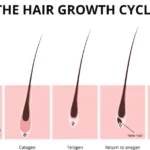So, you’ve noticed your dissolvable stitches sticking out a bit? It’s completely understandable to feel a little concerned. This article provides a comprehensive guide to understanding why this happens, what’s normal, and when you should seek medical advice.
Why Are My Stitches Sticking Out?
It’s not uncommon to find a small piece of dissolvable suture poking out from a healing wound. This often happens as your body naturally breaks down the suture material, much like ice melting. It’s typically a normal part of the healing process and usually nothing to worry about. Dive into the captivating world of catalina lauf for more insights on health and wellness.
Understanding the Dissolving Process
Dissolvable stitches, also known as absorbable sutures, act as temporary scaffolding, holding the edges of your wound together while new tissue forms. As this new tissue strengthens, the stitches gradually dissolve. Sometimes, during this process, a small piece of the stitch might work its way to the surface.
Different Stitches, Different Timelines
Just as different materials dissolve at varying rates, dissolvable sutures have different absorption timelines. Some may disappear within a few days, while others can take several weeks or even months. Factors like the type of suture material (such as Vicryl or Monocryl), the thickness of the suture, the location of the wound, and individual healing rates all play a role. Your surgeon can provide specific information about the expected timeline for your stitches.
Recognizing Potential Problems
While a slightly raised stitch or mild irritation around the area is generally nothing to worry about, it’s crucial to recognize potential warning signs.
When to Seek Medical Attention
- Infection: Increased redness, swelling, warmth around the wound, pus or drainage, increasing pain, a fever, or bleeding that doesn’t stop easily warrant immediate medical attention. These are strong indicators of a possible infection, and prompt treatment is essential.
- Suture Rejection (“Spitting Stitches”): Sometimes, the body may reject the suture material, pushing it out of the skin like a splinter. This can cause inflammation and a small bump at the stitch site.
- Incomplete Dissolution: Occasionally, fragments of the suture material might get trapped under the skin, causing a small, firm bump called a granuloma.
If you experience any of these symptoms, contact your doctor or surgeon immediately.
Caring for Your Wound
Proper wound care is crucial for a smooth recovery.
Tips for Optimal Healing
- Keep it clean: Gently clean the wound as instructed by your surgeon.
- Stay dry: Avoid soaking the wound in water until your doctor gives you the all-clear.
- Hands off: Avoid scrubbing, picking, or pulling at the stitches.
- Follow instructions: Adhere to your surgeon’s post-operative instructions diligently. These are tailored to your specific needs.
- Minimize tension: Avoid activities that put stress or strain on the wound. Unlock the true potential of your Guardian and explore the powerful Destiny 2 Facet of Awakening – but avoid strenuous activities that could strain your wound.
Managing Protruding Stitches
If a stitch is bothering you or seems concerning, contact your surgeon before taking any action. They might suggest trimming the protruding end with sterile scissors, but never pull or yank on the stitch, as this could disrupt healing.
What Others Have Experienced
Here’s what some individuals have shared about their experiences:
- Seeking expert advice: Many emphasize the importance of consulting their surgeon directly for personalized guidance.
- Professional consultation before action: Others highlight the value of seeking professional medical advice before attempting any self-treatment.
- Cautious approach: Some individuals avoided pulling on stitches, opting instead to consult their surgeon about any concerns.
These anecdotes underscore the importance of seeking personalized advice from your healthcare provider.
Ongoing Research and Evolving Knowledge
Current research suggests that the body’s response to dissolvable sutures can vary depending on individual factors. While much is understood about suture absorption, ongoing studies continue to explore the nuances of wound healing and biomaterial interaction. Some experts believe factors like underlying health conditions, medications, and nutrition can influence the absorption rate. There’s also ongoing debate about optimal wound closure techniques and materials.
When in Doubt, Reach Out
Remember, your surgeon is your best resource. If you’re unsure about anything related to your stitches or wound healing, don’t hesitate to contact them. Early intervention can prevent complications and ensure a smoother recovery. This information is for general knowledge and shouldn’t replace professional medical advice. Your surgeon or healthcare provider is your best resource for personalized guidance.
This enhanced and comprehensive guide aims to provide you with all the necessary information about dissolvable stitches. Remember, while some poking can be expected, it’s always best to err on the side of caution and consult your doctor if anything seems unusual or worries you.
















